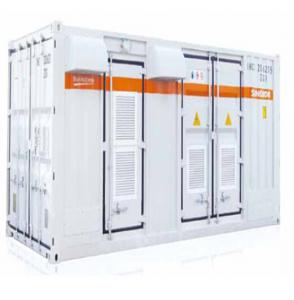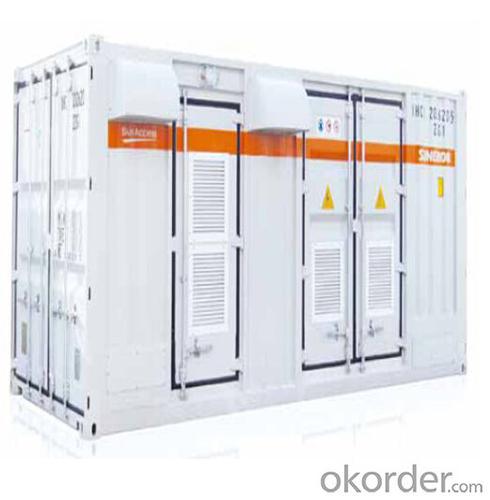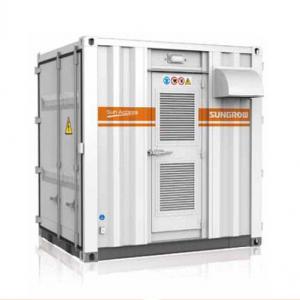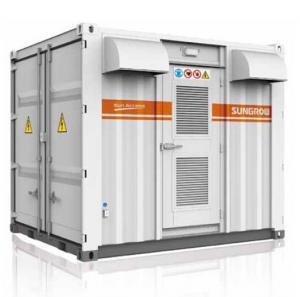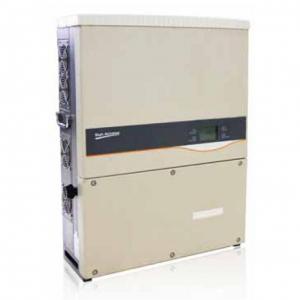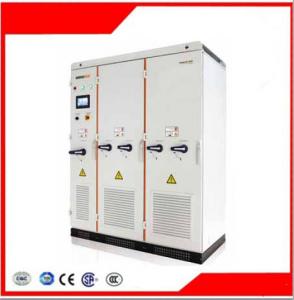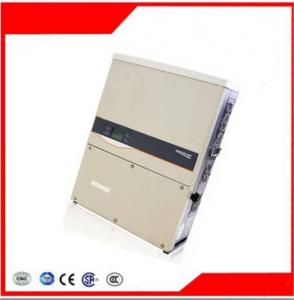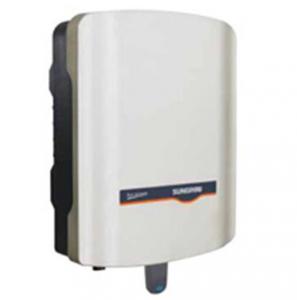Solar Inverter 5000W Photovoltaic Grid-Connected Inverter SG1000TS-MV
- Loading Port:
- China Main Port
- Payment Terms:
- TT or LC
- Min Order Qty:
- 50 unit
- Supply Capability:
- 1000 unit/month
OKorder Service Pledge
OKorder Financial Service
You Might Also Like
1. Structure of Photovoltaic Grid-Connected Inverter SG1000TS-MV Description
A solar inverter, or PV inverter, or Solar converter, converts the variable direct current (DC) output of a photovoltaic (PV) solar panel into
autility frequency alternating current (AC) that can be fed into a commercial electrical grid or used by a local, off-grid electrical network.
It is acritical BOS–component in a photovoltaic system, allowing the use of ordinary AC-powered equipment. Solar inverters have
special functions adapted for use with photovoltaic arrays, including maximum power point tracking and anti-islanding protection.
Suitable for 50Hz/60Hz grid, could be used in Asia, North America and Europe.
2. Main Features of the Photovoltaic Grid-Connected Inverter SG1000TS-MV
• Turn-key solution,high integration
• Integrated PV inverter, DC/AC power distribution, medium-voltage transformer, system monitoring, fire alarm, environment monitoring functional modules and so on
• Save AC cables, lower consumption and promote users’ benefits
• SCADA monitoring system integrated to reduce the costs and ensure the optimal status of the plant
* Easy for Transportation and Handling, Environment Adaptable
• Container design, easy for transportation
• Integral hoisting, easy to install, reduce the installation cost and risks.
• Standard container enclose, integrated design for ventilation, sandproof, anti-corrosion and anti-low-temperature and other application requirements.
* Advanced Technology, Grid-friendly
• Efficiency, energy-saving and reliability as with all Sungrow inverters
• Integrated with standard power dispatch interfaces, convenient and flexible access to power grid;
• LVRT (Zero-voltage Ride-through), Reactive power control with power factor from 0.9 lagging to 0.9 leading, Give reactive power compensation to the grid at night according to directive
3. Photovoltaic Grid-Connected Inverter SG1000TS-MV Images
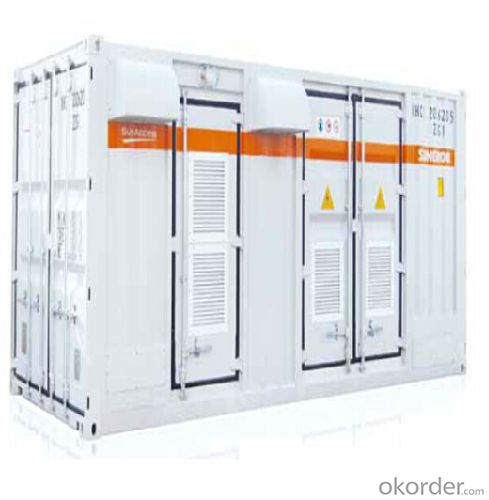

4. Photovoltaic Grid-Connected Inverter SG1000TS-MV Specification
Side Data | |
Max. DC power (@ cos φ =1) | 1120kW |
Max. input voltage | 1000V |
Start voltage | 500V |
Min. working voltage | 460V |
Max. input current | 2440A |
MPPT voltage range | 460~850V |
Number of DC inputs | 16/32 |
Output Side Data | |
Rated power | 1000kW |
Max. output AC power | 1100kVA |
Max. output current | 63.5A |
Max. THD | <3%(at nominal power) |
Rated grid voltage | 10-24kV |
Rated grid frequency | 50Hz / 60Hz |
Grid frequency range | 47~52Hz / 57 ~62Hz |
Power factor at rated power | >0.99 |
DC current injection | <0.5% of rated inverter output current |
Adjustable displacement factor | 0.9 (lagging) ~0.9 (leading) |
Efficiency | |
Max. efficiency | 98.00% |
European efficiency | 97.50% |
Protection | |
DC input side disconnection device | Switch-disconnector with fuses |
AC output side disconnection device | Switch-disconnector with fuses |
DC overvoltage protection | Yes |
AC overvoltage protection on the LV side | Yes |
Grid monitoring | Yes |
Ground fault monitoring | Yes |
Overheat protection | Yes |
Insulation monitoring | Yes |
General Data | |
Dimensions(W×H×D) | 6058x2591x2438mm |
Weight | 12T |
Operating temperature range | -35~50℃ |
External auxiliary supply voltage (Opt.) | 380V |
Cooling concept | Temperature controlled air-cooling |
Degree of protection | IP54 |
Max. permissible value for relative humidity (non-condensing) | 0~95%, non -condensing |
Max. altitude | 6000m (derating > 3000m) |
Communication port/protocols | Standard: RS485/ Modbus, Internet |
Options: CDT, DNP3.0, 101, 103, 104, GPRS/CDMA module | |
5. FAQ of Photovoltaic Grid-Connected Inverter SG1000TS-MV
Q1. What is the difference between inverter and solar inverter?
A1. Inverter only has AC inpput, but solar inverter both connect to AC input and solar panel, it saves more power.
Q2. What is the difference between MPPT&PWM?
A2. MPPT has higher efficiency, it can track the max power point and won't waste energy.
- Q: What is the difference between a string inverter and a micro inverter?
- A string inverter is a type of inverter that is connected to a string of solar panels, converting the DC power generated by the panels into AC power for use in the electrical grid. On the other hand, a micro inverter is a smaller and individual inverter that is attached to each solar panel, converting the DC power directly at the panel level. The main difference between the two is that a string inverter operates at the string level, which means if one panel in the string is affected by shade or malfunction, the entire string's performance is affected. In contrast, with micro inverters, each panel operates independently, allowing for higher energy production and better performance in situations where panels are subjected to shading or varying conditions.
- Q: Can a solar inverter work without sunlight?
- No, a solar inverter cannot work without sunlight. It relies on the energy generated by solar panels, which convert sunlight into electricity. Without sunlight, there is no source of energy for the solar inverter to convert, rendering it inoperable.
- Q: Can a solar inverter be used with a solar-powered CCTV system?
- Yes, a solar inverter can be used with a solar-powered CCTV system. A solar inverter is responsible for converting the direct current (DC) generated by the solar panels into alternating current (AC) that can be used to power the CCTV system. By connecting the solar panels to a solar inverter, the energy produced by the sun can be harnessed and efficiently utilized by the CCTV system.
- Q: Can a solar inverter be used with different monitoring platforms?
- Yes, a solar inverter can be used with different monitoring platforms as long as it is compatible with the protocols and communication standards supported by those platforms.
- Q: How does a solar inverter handle voltage regulation during sudden load changes?
- A solar inverter handles voltage regulation during sudden load changes by continuously monitoring the voltage levels and adjusting the power output accordingly. When there is a sudden increase in load, the inverter will automatically increase its power output to meet the demand and maintain a stable voltage. Conversely, if there is a sudden decrease in load, the inverter will reduce its power output to prevent voltage spikes and maintain a consistent voltage level. This dynamic response allows the solar inverter to effectively regulate voltage during sudden load changes and ensure the stability and reliability of the solar power system.
- Q: What is the role of power ramp rate control in a solar inverter?
- The role of power ramp rate control in a solar inverter is to regulate the rate at which the power output of the solar system increases or decreases. This control is important to ensure the stability and reliability of the grid, as sudden changes in power generation can cause disruptions. By gradually ramping up or down the power output, the solar inverter can respond to grid conditions and prevent overloading or underutilization of the system, ultimately improving the overall performance and efficiency of the solar installation.
- Q: Are there any maintenance requirements for solar inverters?
- Solar inverters do have maintenance requirements, although they are generally reliable and require minimal upkeep. To ensure optimal performance and longevity, regular inspections and maintenance are still necessary. There are several common maintenance tasks for solar inverters. Firstly, it is important to regularly clean the inverter to prevent the accumulation of dust, dirt, and debris on its surface, which can potentially affect its cooling capabilities. This will help prevent overheating and ensure efficient operation. Visual inspection is also crucial, as it allows for the identification of any signs of damage, loose connections, or corrosion that may impact the inverter's performance. Regularly checking for firmware updates is another important task, as manufacturers often release updates to enhance the inverter's performance and functionality. Installing these updates will ensure the inverter operates at its best. Utilizing a monitoring system allows for continuous monitoring of the inverter's performance, enabling prompt identification of any abnormalities or issues. This enables quick maintenance or repair. Lastly, it is advisable to have a professional solar technician inspect and maintain the inverter at least once a year. They can conduct more comprehensive inspections, test the inverter's electrical connections, and troubleshoot any potential issues. By adhering to these maintenance requirements, solar inverters can continue operating efficiently and reliably, maximizing the benefits of solar energy production.
- Q: Can a solar inverter be used for commercial applications?
- Yes, a solar inverter can be used for commercial applications. Solar inverters are an essential component of commercial solar power systems, as they convert the direct current (DC) electricity generated by solar panels into alternating current (AC) electricity that can be used to power commercial buildings and equipment.
- Q: Can a solar inverter be used in a commercial or industrial setting?
- Yes, a solar inverter can indeed be used in a commercial or industrial setting. In fact, solar inverters are commonly used in these settings to convert the direct current (DC) produced by solar panels into alternating current (AC) that can be used to power various electrical loads in the facility. This helps businesses and industries reduce their reliance on traditional energy sources and save on electricity costs while promoting sustainability.
- Q: Can a solar inverter be repaired or replaced if it malfunctions?
- Yes, a solar inverter can be repaired or replaced if it malfunctions. In many cases, minor issues can be repaired by a qualified technician, while more severe malfunctions may require the replacement of the inverter. The specific course of action will depend on the nature and extent of the malfunction, as well as the warranty and service options provided by the manufacturer.
Send your message to us
Solar Inverter 5000W Photovoltaic Grid-Connected Inverter SG1000TS-MV
- Loading Port:
- China Main Port
- Payment Terms:
- TT or LC
- Min Order Qty:
- 50 unit
- Supply Capability:
- 1000 unit/month
OKorder Service Pledge
OKorder Financial Service
Similar products
Hot products
Hot Searches
Related keywords
